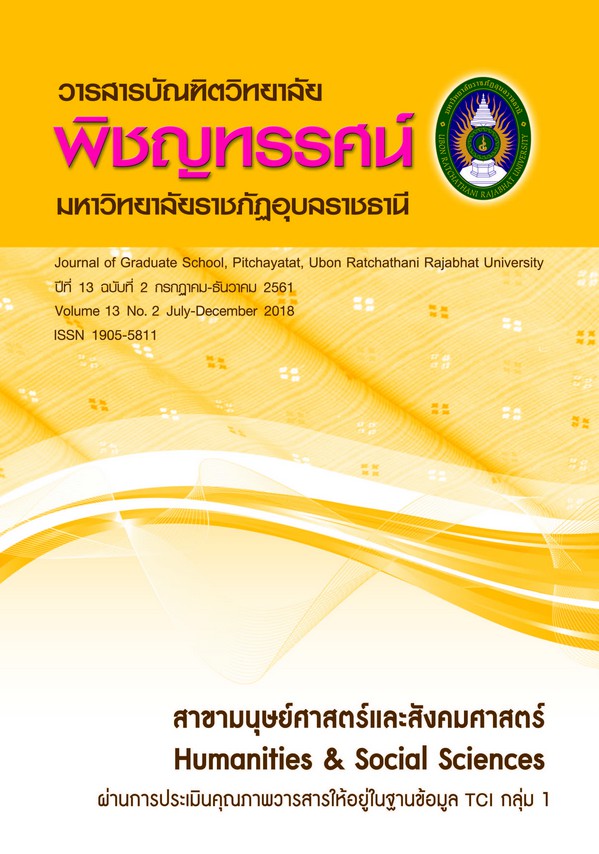The Study Factor of Online Resources with Learning on the Selection of Secondary School Students with Different Cognitive Learner Style
คำสำคัญ:
Learning resources, e-learning resources, Using learning resources, Cognitive styleบทคัดย่อ
This research aimed to study the factor of online resources with learning on the selection of secondary school students with different cognitive learner style. The sample groups of this study were 140 secondary school students; field independent was 75 people and field dependent were 65 people. Learning management plan, e-learning achievement test, the student interview, a survey of the factor of online resources with learning e-learning, data collecting form, cognitive assessment form, student’s manual and teacher’s manual are the research tools. Statistics used in data analysis were frequency, distribution percentage, mean, analysis hypothesis testing with t-test and analysis of variance. The research results were as follows, 1. The students choose social media because there are animations, sounds, entertainment, knowledge and chatting to exchange information. Therefore, they aren’t bored to learn. They always used search engine in every day. It was familiar, memorable, easy access, quick and easy to use. Moreover, many organizations provide (www.) to support their specific targets so, when you need to search, you can use it. 2. The most factors field independent group used were familiarity factor; familiar, knowledge, used in every day, usability factor, can copy file to use in public relations, for teaching and depend on the service factor, technology equipment, searching programs, the tools help for use in shot-time and students in Field Dependent group used in service factor, searching programs, use in short-time, fast to access the information, Usability factor, can copy files to publicize and the sequence factor, the top of sequence were chose the first to use and it wasn’t waste the time for search. 3. The standard deviation and the mean of pre-test score field independent and field dependent group, they were different classifier of cognitive learner style and different pre-test score with the significance level of 0.05. The standard deviation, the mean of post-test score in field independent and field dependent group, they were classifier different of cognitive learner style and different post-test score with the significance level of 0.05
เอกสารอ้างอิง
Asuburn, L., J. and F.B. Ausburn. Cognitive Styles : Some Information and Implication for Instructional Design. Educational Communications and Technology Journal. 26, 4 (May 1978): 337-354.
Bureau of Technology for Teaching and Learning. The New step of Thailand teachers with Social Media. (online) 2009 (Cited September 18, 2017). Available from http://thaismedu.com/
Charles Crawford. 23 Reasons Why People Spend More Time on Social Media. (online) 2014 (Cited December 9, 2017) Available from : https://www.socialmediatoday.com/content/23-reasons-why-people-spend-more-time-social-media.
Everett M.Rogers and F.Floyd Shoemaker, Communication of Innovation. (1971):163-209.
Fredrick, Wayme C., and Herbert J. Klausmeier. Cognitive Styles: A Description. Educational Leadership (23 April 1970): 669-672.
Kanda Runnapongsa Saikaew. Social Media (online) 2011 (Cited September 18, 2017). Available from http:// www.computer.kku.ac.th/?p=1530.
Kobwit Piriyawat. Academic performance. (online) 2011 (Cited September 18,2017).Available from http://teacherkobwit2010.wordpress.com.
Kogan, N., and M.A. Wallach. Modes of Thinking in Young Children. New York: Holt Rinehart and Winston, 1966.
Kusira Charoensuk. Factor Affecting the Use of e-learning Technology by Predegree Student at RamkhamhaengUniversity. Thesis Master of Arts Faculty of Technology Communication Ramkhamhaeng University, 2013.
Messick, S. Individuality in learning. California : Jassey-boss, 1976.
Raksak Lertkhongkhathip. Interaction analysis of concept mapping techniques and cognitive styles in problem-based learning on web upon problem solving skills of anthropology undergraduate students. Thesis Bachelor of Education, Faculty of Educational Communication and Technology, Chulalongkorn University, 2010.
Sornchai Bhudkaew. Development of thought pattern in designing for visual communication. Thesis Doctor of Philosophy, Technical Education Technology, King Mongkut’s University of Technology North Bangkok, 2013.
Surasuk Pahey. Returning Classroom : A New Dimension Classroom in 21st Century. (online) 2013 (Cited September 15, 2017). Available from http://phd.mbuisc.ac.th/academic/flippedped classroom.pdf.
Witkin, H.A.; Moore, C.A.; Goodenough, D.r.; & Cox, P. W. “Field-dependent and field-independent cognitive styles and their. educational implications.” Reviews of Educational Research. 47(1977): 1-64.
ดาวน์โหลด
เผยแพร่แล้ว
รูปแบบการอ้างอิง
ฉบับ
ประเภทบทความ
สัญญาอนุญาต
บทความทุกเรื่องได้รับการตรวจความถูกต้องทางวิชาการโดยผู้ทรงคุณวุฒิภายนอกอย่างน้อย 3 คน ความคิดเห็นในวารสารพิชญทรรศน์เป็นความคิดเห็นของผู้นิพนธ์มิใช่ความคิดเห็นของผู้จัดทำ จึงมิใช่ความรับผิดชอบของวารสารพิชญทรรศน์ และบทความในวารสารพิชญทรรศน์สงวนสิทธิ์ตามกฎหมายไทย การจะนำไปเผยแพร่ต้องได้รับอนุญาตเป็นลายลักษณ์อักษรจากกองบรรณาธิการ





